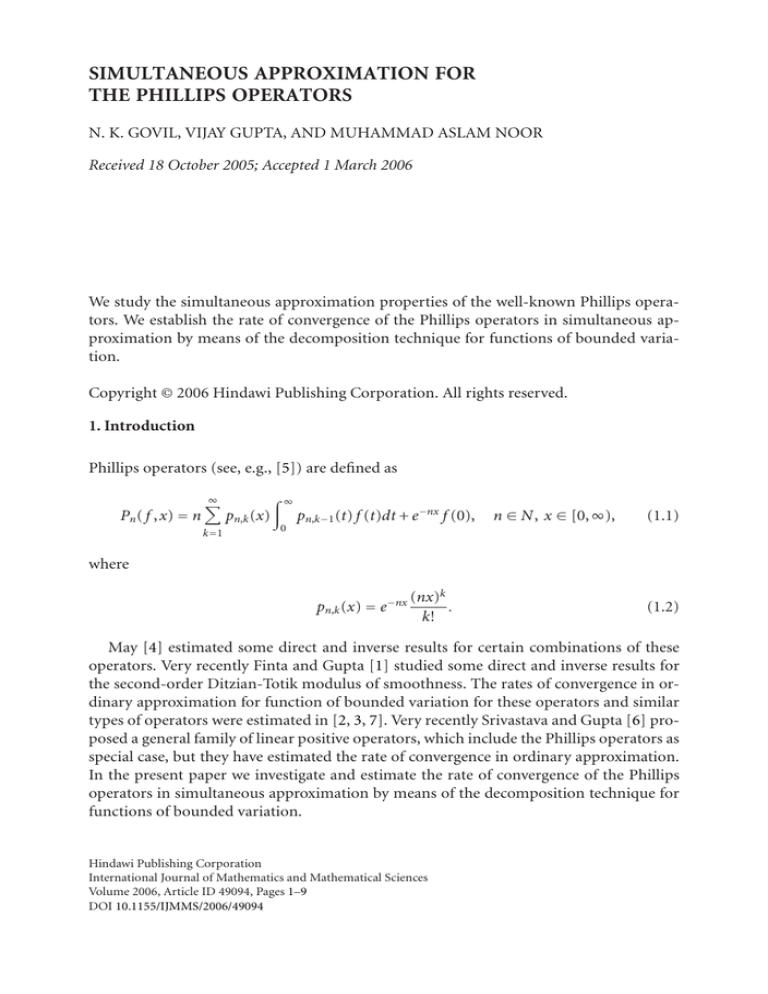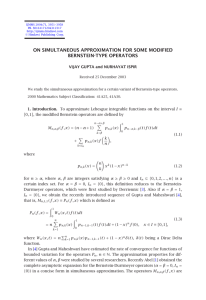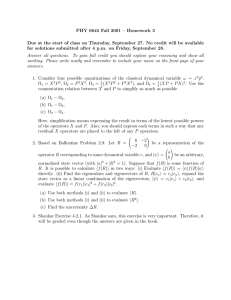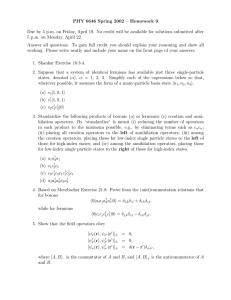
SIMULTANEOUS APPROXIMATION FOR
THE PHILLIPS OPERATORS
N. K. GOVIL, VIJAY GUPTA, AND MUHAMMAD ASLAM NOOR
Received 18 October 2005; Accepted 1 March 2006
We study the simultaneous approximation properties of the well-known Phillips operators. We establish the rate of convergence of the Phillips operators in simultaneous approximation by means of the decomposition technique for functions of bounded variation.
Copyright © 2006 Hindawi Publishing Corporation. All rights reserved.
1. Introduction
Phillips operators (see, e.g., [5]) are defined as
Pn ( f ,x) = n
∞
k =1
∞
pn,k (x)
0
pn,k−1 (t) f (t)dt + e−nx f (0),
n ∈ N, x ∈ [0, ∞),
(1.1)
where
pn,k (x) = e−nx
(nx)k
.
k!
(1.2)
May [4] estimated some direct and inverse results for certain combinations of these
operators. Very recently Finta and Gupta [1] studied some direct and inverse results for
the second-order Ditzian-Totik modulus of smoothness. The rates of convergence in ordinary approximation for function of bounded variation for these operators and similar
types of operators were estimated in [2, 3, 7]. Very recently Srivastava and Gupta [6] proposed a general family of linear positive operators, which include the Phillips operators as
special case, but they have estimated the rate of convergence in ordinary approximation.
In the present paper we investigate and estimate the rate of convergence of the Phillips
operators in simultaneous approximation by means of the decomposition technique for
functions of bounded variation.
Hindawi Publishing Corporation
International Journal of Mathematics and Mathematical Sciences
Volume 2006, Article ID 49094, Pages 1–9
DOI 10.1155/IJMMS/2006/49094
2
Simultaneous approximation for the Phillips operators
2. Auxiliary results
In this section we give the following lemmas, which will be needed to prove our main
result, given in Section 3.
Lemma 2.1. For all x ∈ (0, ∞) and k ∈ N ∪ {0},
pn,k (x) ≤ √
1
,
2enx
(2.1)
√
where the constant 1/ 2e and the estimation order n−1/2 (for n → ∞) are the best possible.
Proof. Following [8], we have
H( j)
pn,k (x) ≤ √ ,
nx
k ≥ j,
(2.2)
where H( j) = ( j + 1/2) j+1/2 e−( j+1/2)√/ j!.
Since max j ≥0 H( j) = H(0) = 1/ 2e, it follows that
pn,k (x) ≤ √
1
2enx
for each integer k ≥ 0,
(2.3)
and Lemma 2.1 is thus proved.
Remark 2.2. The above lemma can be utilized to give better estimate over the main results
of [2, 3, 6].
Lemma 2.3. If f ∈ L1 [0, ∞), f (r −1) ∈ A · C ·loc , r ∈ N, and f (r) ∈ L1 [0, ∞), then
Pn(r) ( f ,x) = n
∞
∞
pn,k+r −1 (t) f (r) (t)dt.
(2.4)
pn,k−1 (t) f (t)dt − n.e−nx f (0).
(2.5)
pn,k (x)
k =0
0
Proof. First by the definition,
Pn(1) ( f ,x) = n
∞
(1)
pn,k
(x)
∞
k =1
0
(1)
Using the identity pn,k
(x) = n[pn,k−1 (x) − pn,k (x)], k ≥ 1, we have
Pn(1) ( f ,x) = n
∞
n pn,k−1 (x) − pn,k (x)
k =1
= n2 pn,0 (x)
+ n2
∞
∞
∞
∞
0
∞
0
pn,k−1 (t) f (t)dt − n · e−nx f (0)
pn,0 (t) f (t)dt − ne−nx f (0)
pn,k (x)
k =1
= n2 e−nx
0
0
pn,k (t) − pn,k−1 (t) f (t)dt
e−nt f (t)dt + n2
∞
k =1
∞
pn,k (x)
0
−1
n
(1)
pn,k
(t) f (t)dt − ne−nx f (0)
N. K. Govil et al. 3
∞ ∞
e−nt e−nt
(1)
−
= n2 e−nx f (t)
f
(t)
dt
−n 0
−n
0
−n
∞
k =1
= ne−nx
=n
∞ ∞
(1)
pn,k (x) f (t)pn,k (t) −
pn,k (t) f (t)dt − ne−nx f (0)
∞
0
e−nt f (1) (t)dt + n
∞
∞
pn,k (x)
0
k =1
∞
∞
0
0
pn,k (x)
k =0
0
pn,k (t) f (1) (t)dt
pn,k (t) f (1) (t)dt.
(2.6)
Thus the result is true for r = 1. We prove the result by induction hypothesis, and for this
we suppose it is true for r = i. Then
Pn(i) ( f ,x) = n
∞
∞
pn,k (x)
0
k =0
pn,k+i−1 (t) f (i) (t)dt.
(2.7)
(1)
Again using the identity pn,k
(x) = n[pn,k−1 (x) − pn,k (x)], k ≥ 1, it follows that
Pn(i+1) ( f ,x) = n
∞
n pn,k−1 (x) − pn,k (x)
k =0
+ n − ne−nx
= n2 pn,0 (x)
+n
2
∞
∞
0
∞
0
∞
0
pn,k+i−1 (t) f (i) (t)dt
pn,i−1 (t) f (i) (t)dt
pn,i (t) f (i) (t)dt − n2 pn,0 (x)
∞
pn,k (x)
k =1
= n2 pn,0 (x)
∞
0
pn,i−1 (t) f (i) (t)dt
pn,k+i (t) − pn,k+i−1 (t) f (i) (t)dt
0
(1)
− pn,i (t)
0
∞
n
f (i) (t)dt + n2
∞
∞
pn,k (x)
k =1
(1)
− pn,k+i (t)
0
n
f (i) (t)dt.
(2.8)
Integrating by parts, we obtain
Pn(i+1) ( f ,x) = n
∞
∞
pn,k (x)
k =0
0
pn,k+i (t) f (i+1) (t)dt,
which was proved and this completes the proof of Lemma 2.3.
(2.9)
Lemma 2.4. For m ∈ N ∪ {0}, r ∈ N, if the mth-order moment is defined by
μr,n,m (x) = n
∞
k =0
∞
pn,k (x)
0
pn,k+r −1 (t)(t − x)m dt,
(2.10)
4
Simultaneous approximation for the Phillips operators
then
r
μr,n,1 (x) = ,
n
2nx + r(1 + r)
.
n2
(2.11)
nμr,n,m+1 (x) = x μ(1)
r,n,m (x) + 2mμr,n,m−1 (x) + (m + r)μr,n,m (x).
(2.12)
μr,n,0 (x) = 1,
μr,n,2 (x) =
Also, there holds the following recurrence relation:
Consequently, by the recurrence relation, for all x ∈ [0, ∞),
μr,n,m (x) = O n−[(m+1)/2] .
(2.13)
Proof. Using the identity x pn,k
(x) = (k − nx)pn,k (x), we have
xμ(1)
r,n,m (x) = n
∞
x pn,k
(x)
k =0
∞
0
pn,k+r −1 (t)(t − x)m dt − mxμr,n,m−1 (x).
(2.14)
Thus
x μ(1)
r,n,m (x) + mμr,n,m−1 (x)
=n
∞
∞
pn,k (x)
k =0
=n
∞
k =0
=n
∞
k =0
+ nx
0
∞
pn,k (x)
∞
k =0
0
∞
pn,k (x)
0
m
t pn,k+r
−1 (t)(t − x) dt + nμr,n,m+1 (x) + (1 − r)μr,n,m (x)
m+1
pn,k+r
dt
−1 (t)(t − x)
∞
pn,k (x)
(k + r − 1) − nt + n(t − x) + 1 − r pn,k+r −1 (t)(t − x)m dt
0
m
pn,k+r
−1 (t)(t − x) dt + nμr,n,m+1 (x) + (1 − r)μr,n,m (x).
(2.15)
Integrating by parts, we get the required recurrence relation. The other consequences
easily follow from the recurrence relation.
Remark 2.5. In particular by Lemma 2.4, for given any number λ > 2 and 0 < x < ∞, we
get for n ≥ 2,
μr,n,2 (x) ≤
λx
.
n
(2.16)
Remark 2.6. We can observe from Lemmas 2.3 and 2.4 that for r = 0, the summation over
k starts from 1. For r = 0, Lemma 2.4 may be defined as in [6, Lemma 2], with c = 0.
N. K. Govil et al. 5
Lemma 2.7. Suppose x ∈ (0, ∞), r ∈ N, and Kr,n (x,t) = n
λ > 2 and for n ≥ 2, there hold
y
0
∞
z
∞
k =0
pn,k (x)pn,k+r −1 (t). Then for
Kr,n (x,t)dt ≤
λx
,
n(x − y)2
0 ≤ y < x,
(2.17)
Kr,n (x,t)dt ≤
λx
,
n(z − x)2
x < z < ∞.
(2.18)
Proof. We first prove (2.17) as follows:
y
0
Kr,n (x,t)dt ≤
y
0
(x − t)2
Kr,n (x,t)dt
(x − y)2
μr,n,2 (x)
λx
≤
Pn (t − x) ,x ≤
≤
(x − y)2
(x − y)2 n(x − y)2
1
2
by using (2.16). The proof of (2.18) follows along similar lines.
(2.19)
3. Rate of convergence
We denote the class Br,α by Br,α = { f : f (r −1) ∈ C[0, ∞), f±(r) (x) exist everywhere and are
bounded on every finite subinterval of [0, ∞) and f±(r) = O(eαt )(t → ∞), for some α > 0},
r = 1,2,.... By f±(0) (x) we mean f (x±).
Now we are ready to prove and state our main theorem.
Theorem 3.1. Let f ∈ Br,α , r = 1,2,..., α > 0. Then for every x ∈ (0, ∞) and n ≥ max{2,4α},
(r)
P ( f ,x) − 1 f+(r) (x) + f−(r) (x) n
2
n
x + 2λ √ r 1/2 2αx
|2r − 1| (r)
(r)
−1/2
√k g
· f+ (x) − f− (x) +
Vxx+x/
λ2
e ,
≤ √
r,x + (nx)
−x/ k
nx
8enx
k =1
(3.1)
where gr,x is the auxiliary function defined by
⎧
(r)
(r)
⎪
⎪
⎪ f (t) − f− (x),
⎪
⎨
gr,x (t) = ⎪0,
⎪
⎪
⎪
⎩ f (r) (t) − f (r) (x),
+
0 ≤ t < x,
t = x,
(3.2)
x < t < ∞,
and Vab (gr,x (t)) is the total variation of gr,x (t) on [a, b]. In particular g0,x (t) ≡ gx (t) as defined in [3].
6
Simultaneous approximation for the Phillips operators
Proof. Clearly
(r)
P ( f ,x) − 1 f+(r) (x) + f−(r) (x) n
2
1 (r)
(r)
≤ Pn(r) gr,x (t),x + f+ (x) − f− (x) · Pn(r) sign(t − x),x .
(3.3)
2
In order to prove the result we need the estimates for Pn(r) (gr,x ,x) and Pn(r) (sign(t − x),x).
We first estimate Pn(r) (sign(t − x),x) as follows:
Pn(r)
sign(t − x),x =
∞
x
Kr,n (x,t)dt −
x
Kr,n (x,t)dt
0
= Ar,n (x) − Br,n (x),
(3.4)
say.
It is easily verified that Ar,n (x) + Br,n (x) = 1. Thus Pn(r) (sign(t − x),x) = 1 − 2Ar,n (x).
∞
−1
Using the fact that k+r
j =0 pn, j (x) = n x pn,k+r −1 (t)dt, we get
Ar,n (x) = n
∞
∞
pn,k (x)
x
k =0
=
∞
pn,k (x)
∞
pn,k (x)
k =0
∞
pn,k (x)
k+r
−1
k
pn, j (x) +
k+r
−1
pn, j (x)
j =0
k =0
j =0
k =0
≤
pn,k+r −1 (t)dt =
pn, j (x)
(3.5)
j =k+1
k
r −1
.
pn, j (x) + √
2enx
j =0
Proceeding along similar lines as in [3], we get
2r − 1|
Ar,n (x) − Br,n (x) = 2Ar,n (x) − 1 ≤ |√
.
(3.6)
2enx
Next we estimate Pn(r) (gr,x ,x), and for this, note that by Lebesgue-Stieltjes integral representation, we have
Pn(r) gr,x ,x =
∞
0
gr,x (t)Kr,n (x,t)dt =
= R1 + R2 + R3 + R4 ,
√
I1
+
I2
+
I3
+
I4
Kr,n (x,t)gr,x (t)dt
(3.7)
say,
√
√
√
where I1 = [0,x − x/ n], I2 = [x − x/ n,x + x/ n], I3 = [x + x/ n,2x], and I4 = [2x, ∞).
t
Let us define ηr,n (x,t) = 0 Kr,n (x,u)du.
√
We first estimate R1 , and for this if we write y = x − x/ n and use integration by parts,
we get
R1 =
y
0
gr,x (t)dt ηr,n (x,t) = gr,x (y)ηr,n (x,t) −
y
0
ηr,n (x,t)dt gr,x (t) .
(3.8)
N. K. Govil et al. 7
By Remark 2.5, it follows that
R1 ≤ V x gr,x ηr,n (x, y) +
y
x
≤ V y gr,x
y
0
ηr,n (x,t)dt − Vtx gr,x
λx
λx
+
n(x − y)2 n
y
0
1
(x − t)
(3.9)
d − Vtx gr,x .
2 t
Integrating by parts the last term, we get after simple computation
y x λx V0x gr,x
Vt gr,x
R 1 ≤
+
2
dt .
3
n
x2
0 (x − t)
(3.10)
√
Now replacing the variable y in the last integral by x − x/ t, we get
n
2λ R 1 ≤
Vxx−x/√k gr,x .
(3.11)
nx k=1
√
√
Next, we estimate R2 , and for this, note that for t ∈ [x − x/ n,x + x/ n], we have
√ gr,x (t) = gr,x (t) − gr,x (x) ≤ V x+x/√ n gr,x .
(3.12)
x−x/ n
Also, by the fact that
b
a
dt (ηr,n (x,t)) ≤ 1 for (a,b) ⊂ [0, ∞), we get
n
√ √ R2 ≤ V x+x/√ n gr,x ≤ 1
√k g
Vxx+x/
r,x .
x−x/ n
−x/ k
(3.13)
n k =1
√
Now to estimate R3 , write z = x + x/ n. Then
R3 =
2x
z
Kr,n (x,t)gr,x (t)dt = −
2x
z
gr,x (t)dt 1 − ηr,n (x,t)
= −gr,x (2x) 1 − ηr,n (x,2x) + gr,x (z) 1 − ηr,n (x,z) +
2x
z
1 − ηr,n (x,t) dt gr,x (t).
(3.14)
Since |gr,x (t)| = |gr,x (t) − gr,x (x)| ≤ Vxt (gr,x ), it follows by Lemma 2.7 that
2x
λx −2 2x −2 z
−2
t
R 3 ≤
x Vx gr,x + (z − x) Vx gr,x +
(t − x) dt Vx gr,x .
n
z
(3.15)
Again integrating by parts, we get
2x
λx
R 3 ≤
2x−2 Vx2x gr,x + 2
Vxt gr,x (t − x)−3 dt .
n
z
(3.16)
Arguing similarly as in the estimate of R1 , we obtain
n
√ 2λ R3 ≤
Vxx+x/ k gr,x .
nx k=1
(3.17)
8
Simultaneous approximation for the Phillips operators
Finally, we estimate R4 as follows:
∞
∞
∞
R 4 = ≤n
K
(x,t)g
(t)dt
p
(x)
pn,k+r −1 (t)eα·t dt
r,n
r,x
n,k
2x
∞
∞
≤
n
pn,k (x)
x k =0
≤
1 n pn,k (x)
x k =0
2x
k =0
0
∞
pn,k+r −1 (t)eα·t |t − x|dt
∞
0
1/2
pn,k+r −1 (t)(t − x)2 dt
n
∞
∞
pn,k (x)
k =0
0
1/2
pn,k+r −1 (t)e2α·t dt
.
(3.18)
To estimate the above first expression we will use Remark 2.5, and to evaluate the second
expression, we note that
n
∞
∞
pn,k (x)
0
k =0
=n
∞
pn,k+r −1 (t)e2α·t dt
nk+r −1
(k + r − 1)!
pn,k (x)
k
∞ nk+r −1
nr
n
Γ(k + r)
=
pn,k (x)
(k + r − 1)! (n − 2α)k+r (n − 2α)r k=0 n − 2α
k =0
=n
∞
∞
pn,k (x)
k =0
∞
0
nr
n2 x
−nx
=
e
(n − 2α)r
n − 2α
k =0
t k+r −1 e−(n−2α)t dt
k
1
nr
=
e2nxα/(n−2α) ≤ 2r e4αx
k! (n − 2α)r
for n > 4α.
(3.19)
If we now combine the above estimate with Remark 2.5, we get
∞
1/2 ∞
1/2
∞
∞
1
2
2α·t
R 4 ≤
n pn,k (x)
pn,k+r −1 (t)(t − x) dt
n pn,k (x)
pn,k+r −1 (t)e dt
x
0
k =0
0
k =0
1/2 2αx
≤ (nx)−1/2 λ2r
e .
(3.20)
Finally, combining the estimates obtained in (3.3)–(3.20), we get the required result, and
the proof of the theorem is thus complete.
Remark 3.2. Since the Bézier variant of the Phillips operators for β ≥ 1 is defined by
Pn,β ( f ,x) = n
∞
k =1
(β)
Qn,k (x)
∞
0
(β)
pn,k−1 (t) f (t)dt + Qn,0 (x) f (0),
(3.21)
where Qn,k (x) = Jn,k (x) − Jn,k+1 (x), Jn,k (x) = ∞
i=k pn,i (x), the rate of convergence in simultaneous approximation for the above Bézier variant of Phillips operators can be obtained
along similar lines. We omit the details.
(β)
β
β
N. K. Govil et al. 9
Acknowledgment
This research was carried out while the second author was visiting Auburn University,
USA, during the fall of 2005.
References
[1] Z. Finta and V. Gupta, Direct and inverse estimates for Phillips type operators, Journal of Mathematical Analysis and Applications 303 (2005), no. 2, 627–642.
[2] V. Gupta and R. P. Pant, Rate of convergence for the modified Szász-Mirakyan operators on functions of bounded variation, Journal of Mathematical Analysis and Applications 233 (1999), no. 2,
476–483.
[3] V. Gupta and G. S. Srivastava, On the rate of convergence of Phillips operators for functions of
bounded variation, Annales Societatis Mathematicae Polonae. Seria I. Commentationes Mathematicae 36 (1996), 123–130.
[4] C. P. May, On Phillips operator, Journal of Approximation Theory 20 (1977), no. 4, 315–332.
[5] R. S. Phillips, An inversion formula for Laplace transforms and semi-groups of linear operators,
Annals of Mathematics. Second Series 59 (1954), 325–356.
[6] H. M. Srivastava and V. Gupta, A certain family of summation-integral type operators, Mathematical and Computer Modelling 37 (2003), no. 12-13, 1307–1315.
[7] H. M. Srivastava and X.-M. Zeng, Approximation by means of the Szász-Bézier integral operators,
International Journal of Pure and Applied Mathematics 14 (2004), no. 3, 283–294.
[8] X.-M. Zeng and J.-N. Zhao, Exact bounds for some basis functions of approximation operators,
Journal of Inequalities & Applications 6 (2001), no. 5, 563–575.
N. K. Govil: Department of Mathematics and Statistics, Auburn University, Auburn,
AL 36849-5108, USA
E-mail address: govilnk@auburn.edu
Vijay Gupta: School of Applied Sciences, Netaji Subhas Institute of Technology, Sector 3 Dwarka,
New Delhi 110075, India
E-mail address: vijay@nsit.ac.in
Muhammad Aslam Noor: Mathematics Department, COMSATS Institute of Information
Technology, Islamabad, Pakistan
E-mail address: aslamnoor@comsats.edu.pk






